Top 10 deadliest snakes in the World
The world in which we live is full of surprises that no one can ever imagine. It is full of wonders that many people don’t even get the chance to know about in their lifetime. It comprises many unknown monstrous beasts, different species of flora and fauna which may be beneficial for human survival or may be harmful to them.
Among the harmful creatures present on the planet Earth are the presences of the deadliest snakes. They are distributed almost in every corner of the Earth. These deadliest and most venomous snakes can kill a human almost immediately after injecting their venom into the human body through their fangs. These toxic substances or so-called venom are produced in the modified salivary gland present inside their mouth. They bite and kill people but not all of them attack unless disturbed or threatened by the humans.
The fear of venomous snakes resides in the hearts of many people although the probability of encountering a venomous snake and dying after being bitten by them is very small. These snakes live primarily in tropical areas, and thick forests, and can also be found in zoos, research centres, museums, and in many more similar places under human surveillance. Following are the 10 deadliest snakes whose venom can take out humans and other animals in one go:
- Inland taipan
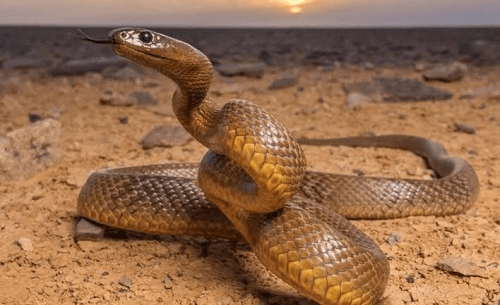
The Inland taipan’s scientific name is Oxyuranus microlepidotus and they belong to the family Elapidae. They are commonly known to the world as western taipan. Ancient people residing in Australia named this snake dandarabilla. Inland taipan’s venom is considered to be the most venomous and lethal to humans and they are considered to be the most ferocious among any other reptile and snakes found in the World.
They usually prefer to live in black soil plains in semi-arid areas in Queensland in Australia. In Queensland, these snakes are mostly found in Durrie Station, Diamantina National Park, Astrebla Downs National Park, Morney Plains Station, Tirari Desert, Goyder Lagoon, Innamincka Regional Reserve, Sturt Stony Desert, Oodnadatta, and Coongie Lakes and near Coober Pedy.
Their venom is so lethal and venomous that it can kill hundred adult humans in a single bite and it can take down a warm-blooded mammal very easily. It attacks its prey with so much accuracy that a single strike can hit the target multiple times.
These snakes are usually not considered the deadliest snake in the world if we look at the number of deaths caused due to their bite every year because the ‘fierce’ word used to describe them are not used for their temperament, it is used to describe their venom. They are generally shy in nature and do not attack humans until and unless they are being cornered or attacked by humans. They attack to protect and defend themselves.
These snakes are found in a rich variety of colours ranging from brownish light-green to a dark hue in different seasons. Their round head and neck are usually darker than the rest of their body such as dark brown in summer and glossy black in winter. Their body colour also vary due to different seasons like during summer their body colour becomes light and during winter their body becomes darker in colour. This colour change due to different seasons helps this species to maintain their body temperature even when their surrounding temperature is different. Their eyes have a blackish-brown iris and are of the average smaller size.
They can grow up to an average length of 6 feet and a maximum of up to 8.2 feet. Their fangs are about 6.1 mm long. Their body mass is between 2 – and 4 pounds. Inland taipan can lay dozens of eggs. Their amount of food intake positively affects their rate of reproduction. These snakes usually survive for 10 years to 15 years.
Whenever they feel a threat from their prey, they usually bend their forebody in an S-shape curve. If their prey ignores their stance, they become furious and their strike becomes even more dangerous than ever. Their most dangerous attack is to rap their prey with its body and delivers the same attack until their prey gives up. Their prey does not even get a chance to defend or attack after just one bite as their toxic venom works quickly.
The symptoms after being bitten by them include hemotoxins where blood gets affected, nephrotoxins where kidneys get affected, and haemorrhaging where blood vessels get affected.
- Coastal taipan
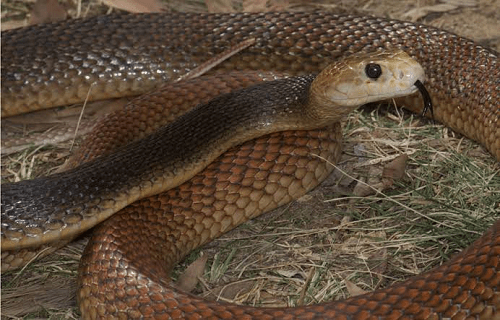
The Coastal or common taipan’s scientific name is Oxyuranus scutellatus. It is known as the second-longest snake that resides in the island of New Guinea and coastal regions of northern and eastern Australia. In the World, after Inland Taipan and eastern brown snake, Coastal taipan snakes are considered to be the third most venomous snake which can be found in open woodlands, sugarcane fields and monsoon forests. They can also be found in hollow logs, abandoned animal burrows and piles of litter and vegetation.
This snake’s upper part has reddish-brown or olive colour shades with lighter shades of the same underneath. They avoid residing in places where the temperature is less than 20 degrees. Adult coastal taipan grows up to an average length of 3.9 ft and a maximum of up to 6.5 ft. However, this record was broken by a specimen whose total length was 9.5 ft. and its weight was 6.5kg. Their fangs are 0.75 inches long.
These snakes breed in the months between August to December and can lay 7 to 20 eggs at a time. It takes about 60 to 80 days for the egg to hatch. The hatchling grows at an average length of 2.6 inches in a month and reaches about 3.3 feet in a year. They can be found in different shades varying from reddish-brown to light olive to dark grey to black. The ventral side is of pale light yellow or creamy white colour. The colour of their skin becomes dark in winter and fades in summer. Their eyes are round and large of hazel or light brown colour with a large pupil.
These snakes take after the eastern brown snake, king brown snake and northern brown snake. They are found in different areas such as wetter temperate regions, warm and tropical coastal regions, wet and dry sclerophyll forests, artificial and natural grasslands, monsoon forests and woodlands. The symptoms of their bite include muscle damage, acute kidney injury, numbness, paralysis, nausea, sweating, abdominal pain, vomiting and low platelet count.
- Banded Krait
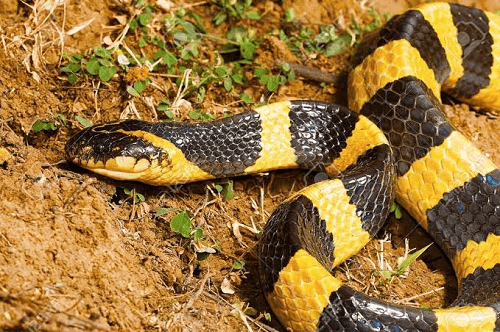
The Banded Krait’s scientific name is Bungarus fasciatus. It belongs to the family of the elapid snakes. It is mainly found in southern China, the Indian Subcontinent and in Southeast Asia. Its average length is 5 ft 11 inches and can grow up to 8 ft 10 inches. They are highly venomous and most active at night. These snakes have large heads with black eyes and they can be easily classified by their yellow and black alternate cross bands on a cross-sectional triangular body.
The banded kraits are found in the Malay Peninsula and Indonesian archipelago, the Indo-Chinese sub-region and southern China. In India, it is commonly found in the states of Manipur, Mizoram, Assam, Tripura, Odisha and West Bengal. They are found in places like villages for rodents, near lakes and rivers. These snakes are often found resting in open plains, pits, drains or grass during the daytime. They are mostly seen during rainy seasons. Upon hatching little young ones measures up to 298 – 311 mm. The length of young ones measures between 298 – 311 mm after hatching and their average length can measure 914 mm on maturing and they become adults in the third year of their life.
These snakes are known by different names in different parts of India based on the dialect of that area such as maipam or rui-teron in Karbi, chawngeli or tiangsir in Mizo, shankhini or shankhamooti shaanp or rajsap in Bengali, welang in Indonasian, linkhak in Manipuri, manjavarayan in Malayalam, ngu sam liam in Thai, Ahiraaj saamp in Hindi, Patteri manyar or agya manyar or sataranjya in Marathi, xokha or xongkhosur or gowala or bandphora in Assamese, Ngan taw kya in Burmese, rana in Odia, katla paamu or bangaru paamu in Telugu, kadambale in Tulu, kattu vinyan or yennai vinyan or yettadi vinyan in Tamil, gangali or gan gwali or rajasaap in Nepali, and ran cap nong in Vietnamese.
These snakes are primarily nocturnal and shy so it is not that dangerous for humans because they usually don’t bite unless threatened. But if they bite us, then we may experience symptoms such as dizziness, abdominal pain, vomiting, diarrhea and respiratory problem. It can cause nephrotoxins; a condition where kidneys get affected; if bitten.
- Russell’s viper
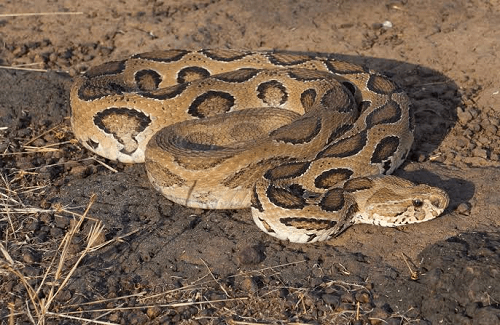
Russell's viper is a venomous snake that belongs to the family Viperidae. It is known by its scientific name as Daboia russelii and was named after Patrick Russell.
Patrick Russell wrote about his experiments which he performed on dogs and chickens and confirmed that these snakes have an extremely poisonous nature and added that they were known by the name katuka, retula, or poda by the native people.
It is found in Bangladesh, India, Sri Lanka, Pakistan and Nepal. It can be commonly found in few areas such as in Punjab, along the West Coast and its hills and in southern India (especially in Karnataka) and can be very rare in other areas such as in Assam, northern Bengal and in the Ganges valley.
Russell's viper can be found anywhere but it does tend to avoid dense forests. These snakes are mostly found in open and bushy areas, but can also be found on forested plantations, scrub jungles and farmland. Generally, they avoid living in humid environments, swamps, marshes, at high altitudes and in dense rain forests.
People should avoid working outside in highly urbanized areas and settlements in the countryside if possible because they are at risk of being bitten by this species of snake. These snakes are known by different names in different parts of India based on the dialect of that area such as Kannaadi virian in Tamil, Kolaku mandala in Kannada, Thith Polanga in Sinhala, Rakta pinjari in Telgu, Chenathandan or Manchatti in Malayalam, Ghonas in Marathi, Kandadi in Tulu, Chandraborha in Bengali, Chandra Boda in Odia and Chitar in Gujarati.
Russell's viper's head is triangular, flattened and distinct from the neck. Their snout is raised, blunt and rounded. Their head is covered with irregular fragmented scales. Their eyes are large and are marked with gold or yellow colour. The average length of their fang is 0.65 inches.
Their colour pattern consists of a brown ground colour or deep yellow; with three series of dark brown spots, with a black ring around it, which runs throughout their body. Their maximum body length along with their tail can reach up to 65 inches and their average length is about 47 inches.
The venom of these snakes is extremely venomous. The symptoms after being bitten by them include extreme pain and swelling, bleeding from urine and gums, decreased heart rate, low blood pressure, blisters, vomiting, renal failure and damaged tissues.
- Eastern tiger snake
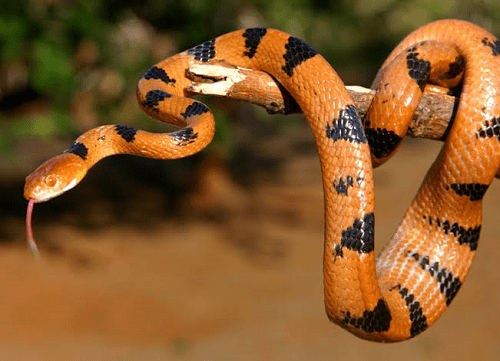
Eastern tiger snake’s scientific name is Notechis scutatus. Eastern tiger snakes are highly venomous and large snakes found in Tasmania and the southern and coastal islands of Australia. Just like a tiger, these snakes are well identified by their combination of black and yellow colour patterns. They can also have different patterns and colours. These snakes generally reside on the ground; they climb trees, and buildings and can swim. Their venomous sharp fangs are located in the front or rear of the mouth. The Tiger snake’s closest relative is a rough-scaled snake whose scientific name is Tropidechis carinatus.
There are different names for the subspecies of Tiger snake; such as Notechis ater serventyi in Chappell Island, Notechis ater humphreysi in King Island and Tasmanian and Notechis ater Niger in the Peninsula.
Notechis belongs to the family of Elapidae and they are only found in the subtropical and temperate regions of Australia. These snakes grow up to 3 ft 11 inches. The colours of these snakes vary from pale to very dark colours. The shades of their vertebral scales are of yellow, olive, jet-black, or orange-brown colour and the underside of these snakes is of orange or light yellow colour. These snakes may be very active on warmer nights and they can also tolerate low temperatures.
They flatten their bodies when threatened and raise their heads above the ground in a classic prestrike stance. They favor habitats around watercourses, wetlands, creeks, dams, or shelters near permanent sources of water. They live in large numbers in places that provide them with a large number of prey. The common tiger snake has a flat, thick head that is slightly distinct from a wholesome body. Their scales are like an overlapping shield around the neck.
The accurate identification of the subspecies can be done by counting their scales or by performing a venom test instead of differentiating them on the basis of their scale colour.
Tiger snakes can give birth to 20 to 30 live young at once but this record was broken by an eastern female snake that gave birth to 64 live young. Their mating season is in spring when it is warm and they give birth to live young in the summer season.
Their venoms contain haemolysins, coagulants, myotoxins and neurotoxins. The symptoms of their bite include numbness, localized pain in the foot and neck region, sweating and tingling sensations followed by difficulty in breathing and paralysis.
- Saw-scaled viper
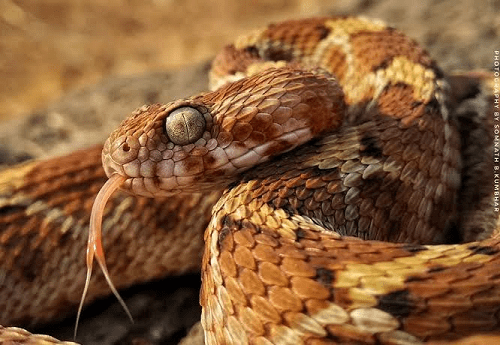
Saw-scaled vipers are also known as carpet vipers and Echis. They are considered to be one of the venomous vipers found in the dry regions of the Middle East, Africa, Pakistan, India and Sri Lanka. The word ‘Echis’ comes from the Latin transliteration of the Greek word “viper”. There are twelve species of saw-scaled viper known to the world and they are held responsible for most of the death caused by snakebites.
Saw-scaled vipers are relatively small as compared to other snakes, and the largest species are usually below 35 inches long and the smallest being around 12inches long.
Their head is generally distinct from the neck and is relatively smaller, wider and pear-shaped. Their body is reasonably slim and cylindrical in shape. Their eyes are relatively large but their snout is round and short and their subcaudals are single. Their dorsal scales are mostly capsized.
These snakes are found in Sri Lanka, India, parts of Africa and the Middle East, Pakistan, and the areas north of the equator.
They threaten their prey by producing a sizzling sound of water on a hot plate by rubbing the different sections of the body together as a sign of warning. This is termed stridulation and this behavior becomes louder and faster when they get excited or worried. This is accompanied by loud hissing. These snakes can be very aggressive and frightening and they may lose their balance and end up moving toward their attacker which is defined as an unusual behavior for snakes.
Saw-scaled vipers are considered to be one of the highly aggressive creatures compared to many of their species as they usually strike to bite.
The snake venom of these species consists mostly of cardiotoxins, cytotoxins, neurotoxins and hemotoxins. This genus has a medical significance in many tropical rural areas. They are mostly found everywhere and live in underdeveloped areas which lack modern medical facilities. These snakes are mainly active during the nighttime and mostly bite their victims during this time of the day.
The venom of this species contains factors that can cause infection, inability to clot blood, cancer, inflammation and defibrination, and may continue for a few days or for a few weeks.
- Fer-de-lance
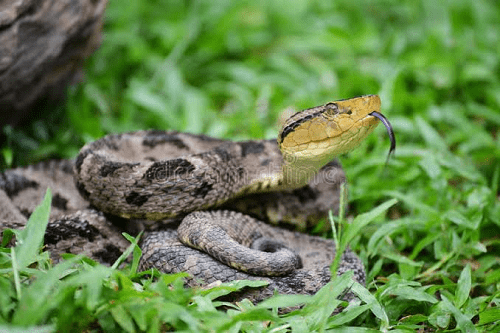
Fer-de-lance resides in Central American countries, Honduras, Mexico, Guatemala, Costa Rica, Panama, Nicaragua and Belize. Bothrops asper is its scientific name.
They grow up to 4 ft – 6 ft and their body mass is about 6 kg. Female fer-de-lance’s body mass is much more than males as they can grow up to 8 ft. Their speed can reach up to 16 kph to 19 kph. It can also be found in other habitats including lower mountainous regions, lowlands, pine savannah, thorn forests, near rivers, streams or lakes, in Mexico’s cloud forests and in drier parts of tropical deciduous forests. Land cleared for agricultural activities is promptly occupied by these snakes.
These snakes are very adaptable in almost all habitats and are usually found near human settlements, therefore, they are considered extremely dangerous to humans. The name fer-de-lance was originally used to refer to the Martinique lancehead / Bothrops lanceolatus in French. But the name fer-de-lance is often used to refer to snakes of the genus Bothrops / Bothrops atrox in North America.
These snakes are known by different names in different parts of the country such as Yellow Beard / Barba Amarilla in Honduras and Guatemala, Terciopelo in Spanish, Nauyaca in Panama and Mexico, Taya Equis in Ecuador and Tommy Goff and Yellow jaw in Belize. Just like the other snakes in the genus Bothrops, these snakes have a flattened and broad head of black or medium to dark brown colour which differentiates them from other snakes. They sometimes have occipital blotches or streaks which makes them more or less distinct.
These snakes are the main cause of snakebite incidents in the world as they are typically found near the human habitat. Severe swelling, nausea, local pain, vomiting, numbness, necrosis, bruising and blistering are some of the common symptoms of snakebite incidents.
They have very powerful venom which destroys the red blood cells present in the body and prevents the blood from clotting. These snakes are responsible for half of the snakebite incidences and one-third of hospitalization cases. As a result, they are considered to be one of the most dangerous and venomous snakes in Costa Rica
- King cobra
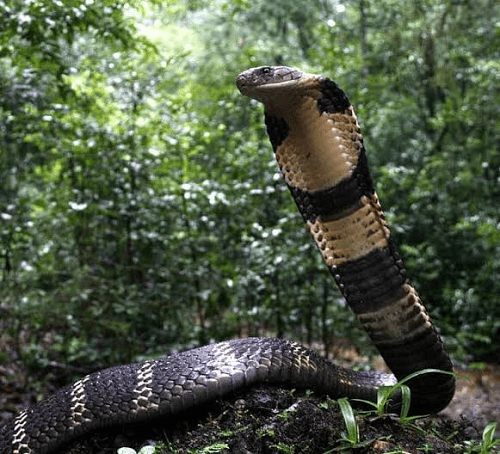
King cobra is known as the most intelligent and longest venomous snake among other snakes in the world. They have the ability to recognize their territory boundaries. Ophiophagus Hannah is its scientific name.
King cobras are found in southern and eastern China, including Hainan and Hong Kong; throughout the Malay Peninsula; north India; the Philippines; and west to eastern Indonesia. Its length ranges from 3 to 3.6m and can reach up to 5.4m. They weigh about 13 pounds. They also have the ability to identify their trainer/supervisor from other people.
Their toxin can kill a human in just a few minutes an animal as big as an elephant gets killed in just a few hours as the nervous system gets slowed and shut down leading to paralysis.
- Black mamba
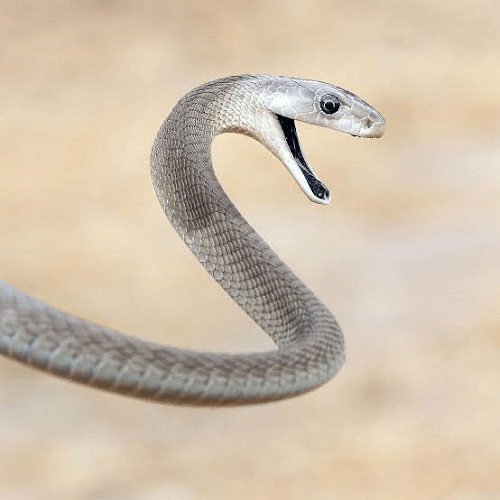
Black mamba resides in East South and East African savannas, open woodlands and rocky hills. They like open, low spaces and enjoy sleeping in rock crevices, hollow trees, empty termite mounds or burrows. The venom of Black Mamba is extremely dangerous because our nervous system gradually slows down and eventually shuts down making our body paralyzed.
Although its name says ‘Black’ Mamba, the snake is not black. Instead, it ranges from dark brown to grey, with a lighter underside. The inside of the mouth of a Black mamba is of the colour ‘black’ and green mambas and others have white mouths. It is found in lowland forests and rocky savannas.
The average adult black mamba measures 2–2.5 meters and can grow up to 4.3 meters. Their body mass is about 1.6kg. The black mamba is feared by almost all because of its length and speed and they possess some extremely potent venom that kills its human victims. Although it is extremely dangerous, it accounts for only a small number of deaths annually.
- Boomslang
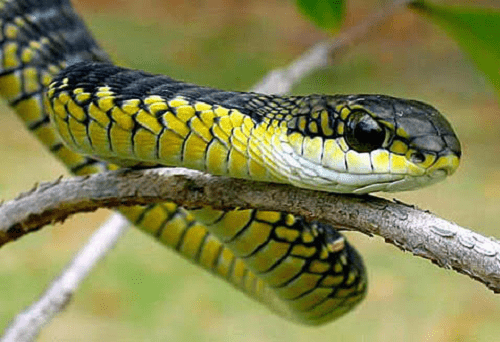
Boomslang is one of the most dangerous snakes found in sub-Saharan Africa. Dispholidus Typus is its scientific name. Except for the continent of Antarctica, it is found in every other continent present on Earth. Its fangs are located in the back of the jaw, and it delivers its venom by chewing on its prey until the victim stops fighting. The snake can measure up to 2 m long but is about 1m - 1.6m in length.
Skin colour varies; female snakes have dull olive-brown or grey colour shadows, whereas, males have colour shadows from solid bright green to rust-red or a combination of yellow and black. Young ones are quite spectacular with bright green eyes, and white throats with light reddish-brown coloured bodies. Their weight varies from 175 grams to 510 grams, with an average weight of 299.4 grams.
An adult Boomslang contains 1.6 mg - 8 mg of venom. Humans can suffer from major brain and muscle haemorrhage as the red blood cells present inside our body gets destroyed because of Boomslang’s venom. But the venom also causes other symptoms like nausea, sleepiness and headaches.
Conclusion
If you want to spend your precious vacation in places such as the countryside, near deserts, beaches, and oceans then you should be extra careful not to fall prey to the above-mentioned snakes or any other venomous snakes. You should also be careful about the fact that you do not disturb the snakes or make them feel threatened or cornered by you as your life could be in danger just because of some entertainment or excitement you get while teasing the wildlife.
And if you don’t want your life to be in danger then you could visit a mammalogical park. A visit to the zoological park can help you to spend your vacation safely along with increasing your knowledge about snakes and other animals.
If you and your friends plan to go for a hike then you should always wear long pants and boots to block the snake bite and always remember that if you or your friends get bitten by a snake then quickly cover the wound with a sterile bandage and lie down in such a position that the wounded area is below the heart level and try to remain as calm as possible so that the venom does not spread in your body. Afterwards, you should visit a doctor to get proper treatment as the above-mentioned procedure was a simple first-aid performed to preserve your life and to stop the venom from spreading.